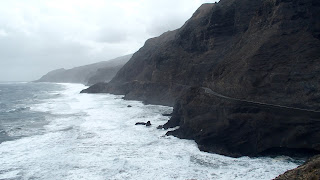We left the Canadian winter behind early this year arriving
in Tenerife on Jan. 8. Leaving home is always
a bitter sweet experience, looking forward to new horizons while missing the
comforts of home and family. Easton
For the first week we had a car to help us stock the boat
for forward passage and the purchase of boat parts. The marina, though very
secure was a ways out. Once launched, we
headed into Santa Cruz
We had daily visits from boat hitchhikers, boys and girls
alike looking for passage to Cape Verde
or the Caribbean , wanting sailing experience
and offering help on the passage.
Once all our jobs were complete we waited for that weather
window, leaving 3 weeks after our arrival. Our departing view of Tenerife was the snow capped mountains through the mist. The promised fair weather did not
materialize. The passage was lumpy and cold, to say the least. Heavy swells and
strong winds made it possible to see the sunset 5 times in one night. But, we
made the 900 mile trip in exactly 7 days, down to the hour.
 |
| Sighting Landfall - Cape verdes |
 |
| Mindelo harbour - the 20' boat next door is crossing over |
 |
| Anchorage outside Mindelo harour |
 |
| The town of Mindelo |
Our destination, Mindelo ,
Cape Verde
Supplies are limited and since it is winter fresh fruit and
vegetables are scarce..
The colourful markets are a daily event and we are amazed by
the women carrying huge baskets of produce on their heads.
When the archipelago was discovered by European explorers,
they encountered islands carpeted in green. As a source of food for subsequent
passages they introduced goats, which stripped the landscape bare. Today in
conjunction with drought, little vegetation remains. The island where we are
based is essentially a volcanic sand pile.
 |
| Dessert like Sao Vicente |
 |
| These were some good ones |
Children in the remote areas only attend school up to grade
6, unless their parents can afford to board them in a more central location.
Plus they are required to pay for all books themselves.
 |
| NE part of Santa Antao |
 |
| Banana Valley - Santa Antao |
 |
| Remains of the volcano caldera on Santa Antao |
 |
| Terraced farming for sugar cane, coffee, yams |
 |
| Kids carnival dress - witches, vampires, mice seemed most popular?? |
 |
| Main road around Sao Antao - hand built |
Carnival has just arrived in the islands and it is
overwhelmingly loud!! carrying on into the wee hours of the morning. Celebrations will go on for the rest of the
month but we are on the eve of departure heading for Barbados- 2000 miles. The
trip is termed a milk run, but here is hoping it doesn’t leave us feeling like
the trip to Cape Verdes
 |
| Hand built road covers Santo Antao - volcanic rock road surface |


